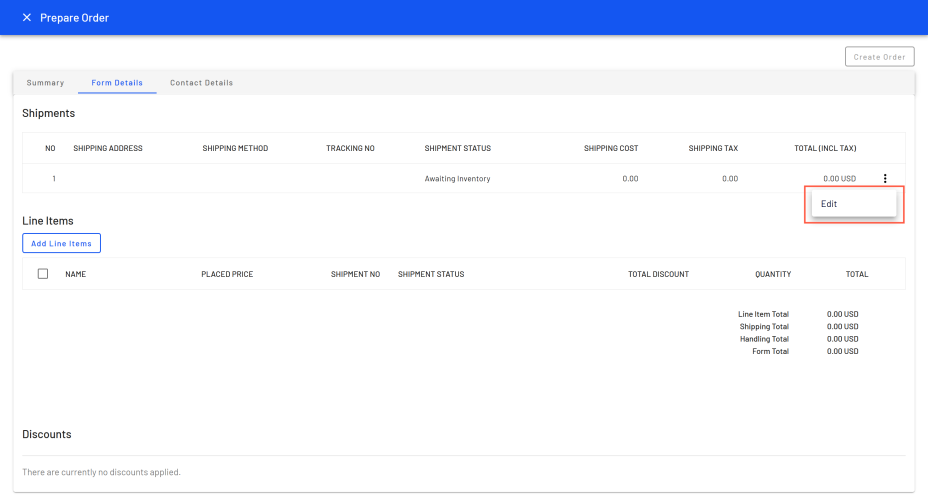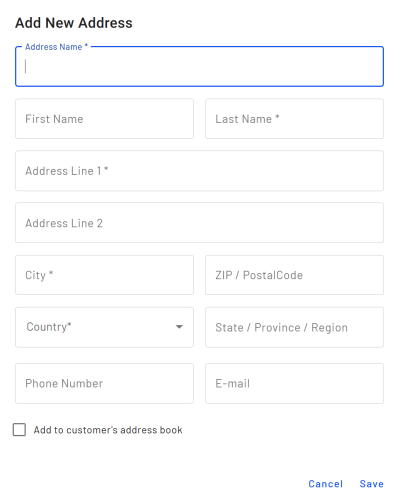 Working with purchase orders
Working with purchase orders
This topic describes how to work with purchase orders on the Order Management screen.
Once a customer checks out and submits payment, a cart is converted to a purchase order. Alternatively, on the Cart Details screen, CSRsStands for "customer service representative" can convert a cart to a purchase order whether or not payments have been made.
Alternatively, you can create a new purchase order.
While the purchase order's status is In Progress, you can edit any of its information (shipping address or method, line items, discounts, and so) on by clicking the Form Details tab.
Searching for purchase orders
You can search for purchase orders by customer name (partial match), order number (exact match), or email address (exact match).
- In the top left corner of the Order Management screen, click Orders.
- In the Search by drop-down, select Search by Name, Search by Order Number, or Search by Email.
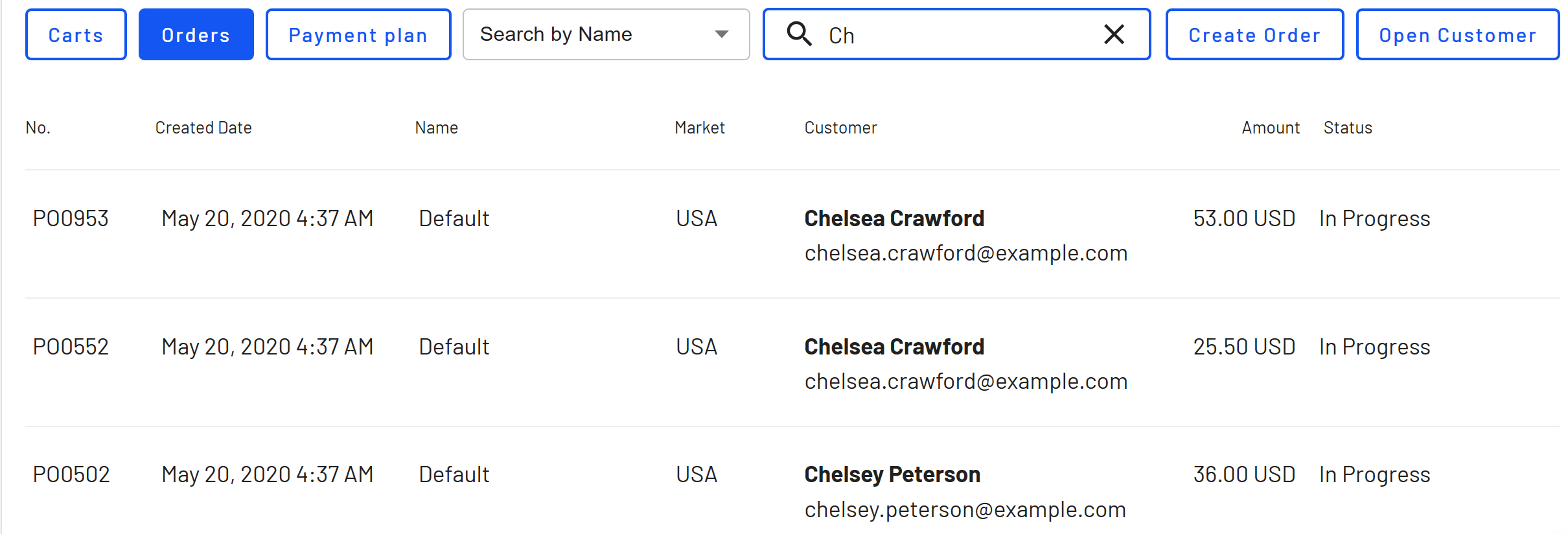
- If you chose Search by Name, move to the Search box and begin entering the customer's first name. For example, if the customer name is Bryan Stephens, enter B, Br, or Bry. Press Enter to execute the search.
- You can enter the entire name, but this takes longer.
- As you enter more characters, you get fewer search results.
- You cannot find a customer by entering the last name. To continue the example, you cannot find Bryan Stephens by entering Ste.
- If you chose Search by Order Number, enter the complete purchase order number. Partial entries are not allowed.
- If you chose Search by Email, enter the exact email address. Partial entries are not allowed.
- If you chose Search by Name, move to the Search box and begin entering the customer's first name. For example, if the customer name is Bryan Stephens, enter B, Br, or Bry. Press Enter to execute the search.
- Orders that match your search criteria appear.
Converting a cart to a purchase order
Typically, a shopping cartCommerce: A collection of products selected by a website customer, with the intention of completing a purchase. Also known as a shopping cart or basket. is converted to a purchase orderCommerce: An order that has been registered and paid for. Typically, it has an associated purchase order number. when a customer proceeds to checkoutCommerce: Completing a purchase on a website, involving the collection of shipping and billing address, shipping method, payment, and so on. and finalizes the purchase. However, you may need to manually complete a purchase by converting a shopping cart into an order for further processing. For example, you want to record manual payments towards outstanding balances, such as telephone payments.
Use the Cart Details screen to convert a cart to a purchase order.
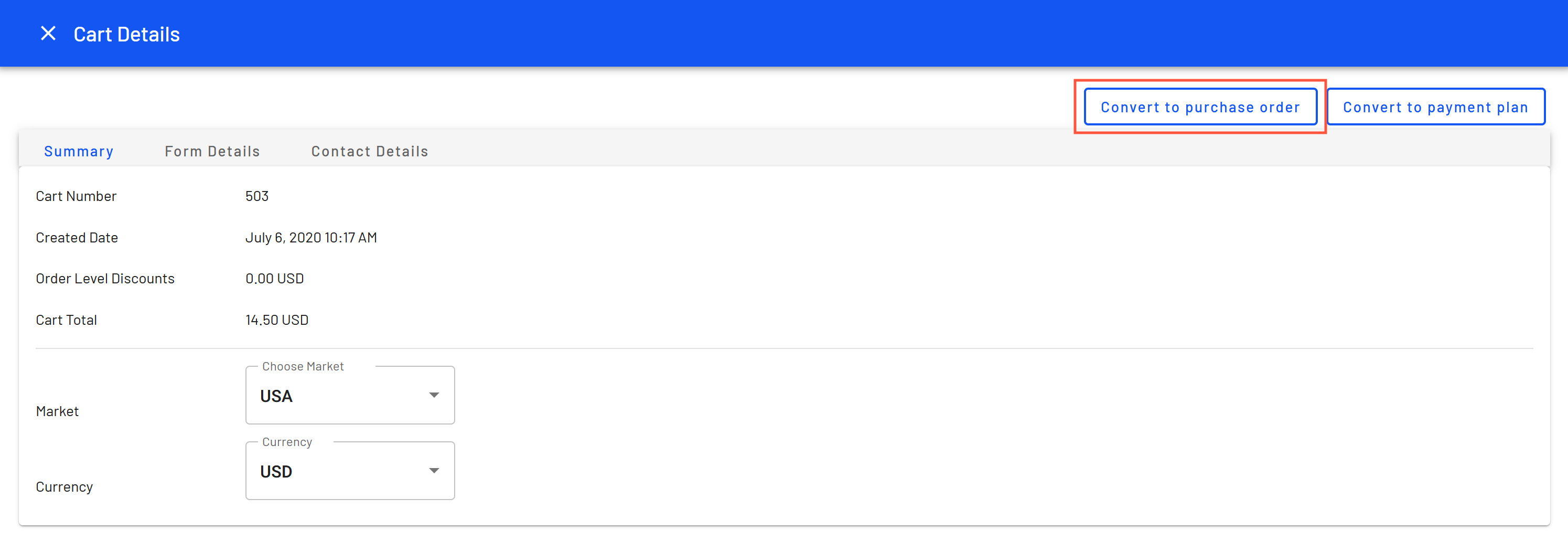
Creating an order
For example, a customer calls on the phone and orders some items. To create a new purchase order in Episerver Commerce, do the following:
- From the Order Management screen, click Orders > Create Order.
- Choose the order's marketOne or more countries, regions or customer groups, to which you want to apply languages, catalogs, currencies or promotions. The market features support targeted merchandising and personalization..
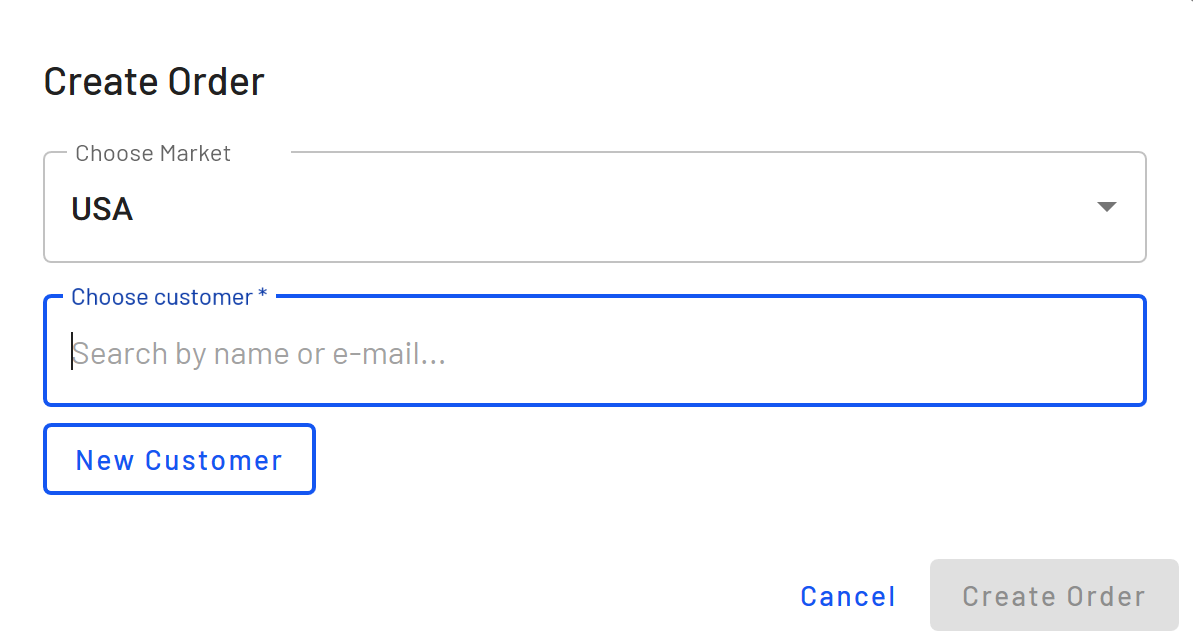
- Choose an existing customer or create a new one.
- To find an existing customer, enter any part of the customer name or email address. A list of matching customer names appears. Select the customer.
- To enter a new customer, click New Customer. The Create Contact dialog appears. Enter the customer's name, email address, and customer groupCustomer groups are created in Commerce Manager then applied to contacts and organizations. Customer groups are common to both contacts and organizations, and you can apply them to customer segments that are targeted for marketing campaigns and customer group-specific pricing, including variants..
- Click Create Order.
- Click the context menu to the right of shipment 1 and click Edit.
- Enter the order's shipping address and shipping methodCommerce: A set of information and rules that determine the shipping cost. Displayed on the front-end public site while a customer checks out an item from the shopping cart. The shipping fee is added to the total price of the purchase. A shipping method is mapped to a shipping provider visible to a back-end administrator in Commerce Manager. For example, when a customer picks "Ground Shipping," UPS (or another provider) may fulfill the shipment..
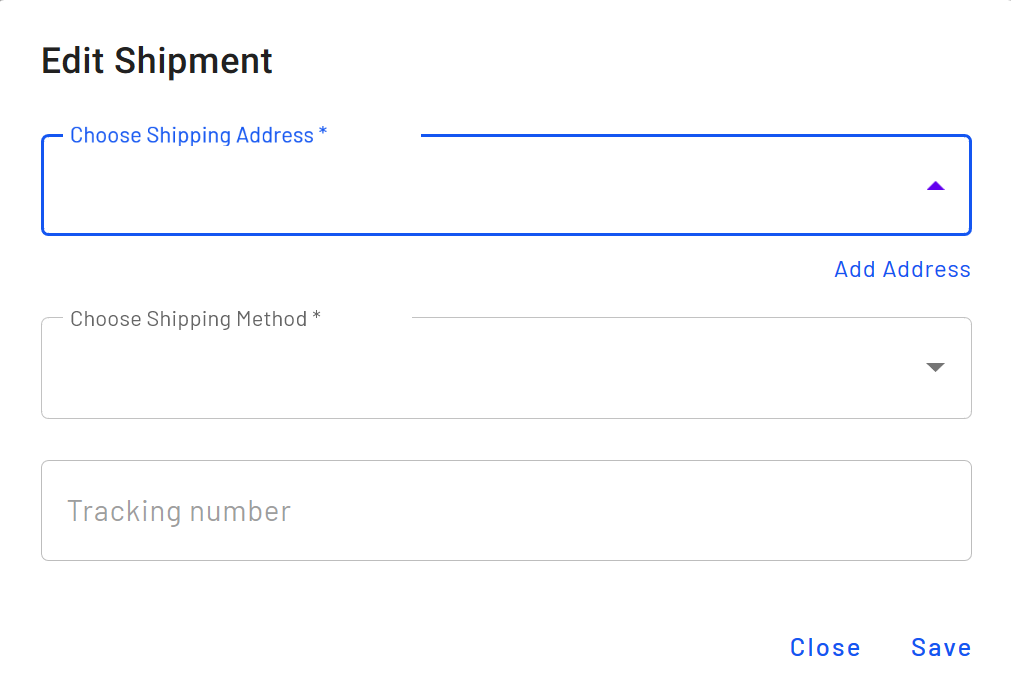
If you want to add a separate shipping address to this order, see Adding a new shipping address to an order.
- Click Save.
- Click Add line items.
- In the Product Variant field, enter a search phrase of three or more characters. Examples:
- The entire SKUCommerce: Stock keeping unit; corresponds to a purchasable product with specific characteristics. For example, a product line of shirts has individual variations/SKUs for sleeve size, color, and collar size., for example, 44477844.
- All or part of the item name or description, for example, boot.
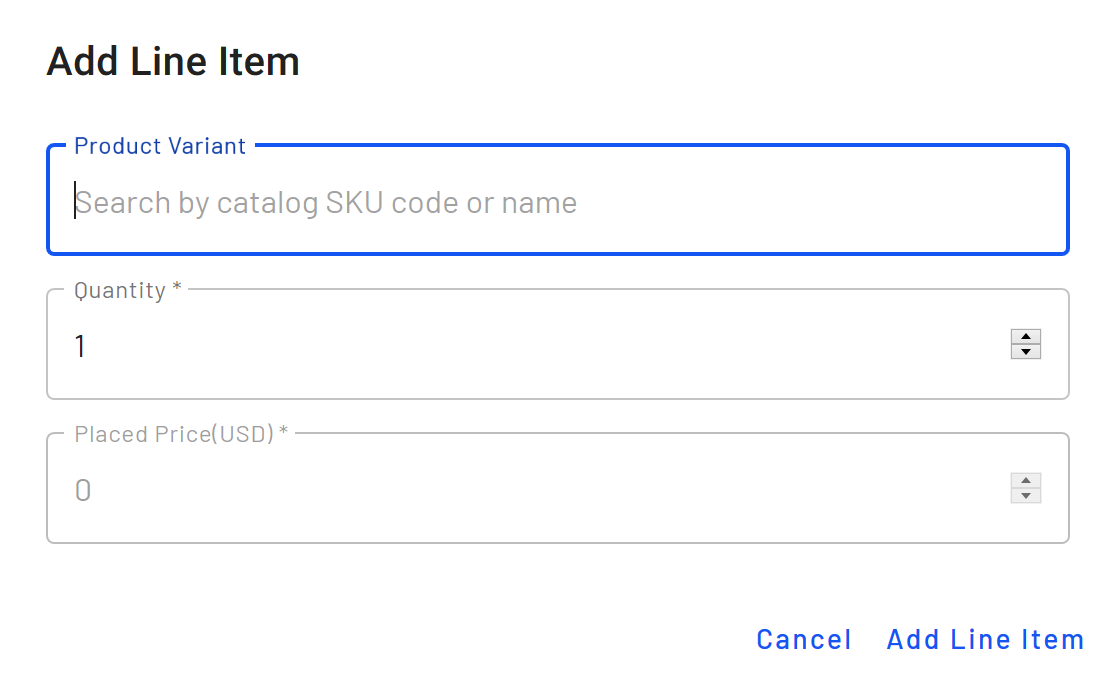
- Choose a quantity and price. The default placed price appears, but you can change it.
- Click Add Line Item.
- After adding at least one item, click Create Order.
Although the order is created, it must be paid before it can be released, as explained in Shipment, order and return statuses. See also: Recording purchase order payments.
Recording purchase order payments
- From the Order Management screen, click Orders.
- Select the order you want to edit.
- If needed, edit the previously-collected information. See Editing carts.
- Click the Form Details tab.
- If the full amount has not yet been paid, click Accept Payment to add or update payment information.
- Billing address
- Payment methodContains information about the way a customer views a payment option and has a payment gateway associated with it. Examples: credit card, pay by phone, cash on delivery, and exchange payment.
- Transaction ID and amount
- Any meta-classes and fields that apply to the order, its shipments, and line items.
Placing an order on hold
When a shopping cart is converted to a purchase order, its status is set to In Progress. You may need to place the order on hold for several reasons. As examples: the retailer needs to verify the order, a suspicious order needs attention, inventory is not available, and so on.
To place an order on hold, click Order Management and select the order. Then, on the Order Details screen, click Hold.
While an order is on hold, it cannot be released for shipment nor can it be canceled.
Canceling an order
To cancel an In Progress purchase order, click Order Management and select the order. Then, on the Order Details screen, click Cancel Order.
At that point, its order and shipment statuses change to Canceled.
Deleting an order
At this time, you can only delete an order through Commerce ManagerOne of several main user interfaces in Episerver Commerce. This UI area, available from the top menu after logging in, provides screens for managing markets, customers, catalog, orders, and so on. You can manage the information on some Commerce Manager screens in other, newer user interfaces. Where possible, we recommend using the newer ones.. See Deleting an order.
Adjusting an order's shipment status
For information about order status versus shipment status, see Shipment, order and return statuses.
- When an order is paid in full
- If the quantity of any item in an order exceeds the available Instock Quantity, its shipment status is set to Awaiting Inventory.
- If the quantity of all items in an order is less than the available Instock Quantity, its shipment status is set to Inventory Assigned.
- When an order is paid and ready for shipping, click the Form Details tab and select Release from the context menu.
- To prepare an order for shipping, change the shipment status to Packing by clicking ADD TO PICKLIST.
- When the shipment is shipped, change the shipment status to Shipped by clicking COMPLETE.
If you want to support preorders, their shipment status will be set to Awaiting Inventory.
At this time, you must use Commerce ManagerOne of several main user interfaces in Episerver Commerce. This UI area, available from the top menu after logging in, provides screens for managing markets, customers, catalog, orders, and so on. You can manage the information on some Commerce Manager screens in other, newer user interfaces. Where possible, we recommend using the newer ones. to complete the following shipping tasks:
- Create picklist and print picklist and packing slip
- Remove items from picklist
- Delete a picklist
- View shipments
- Split a shipment
- Complete a shipment, that is, record shipment information such as tracking number
Adding a new shipping address to an order
To add a new shipping address to an order without editing an existing address or adding a new address to the customer's address book, do the following:
- From the Order Management screen, click Orders and select an order. The Order Details screen appears.
- Open the Form Details tab.
- Click the context menu to the right of shipment 1 and click Edit.
- Click Add Address.
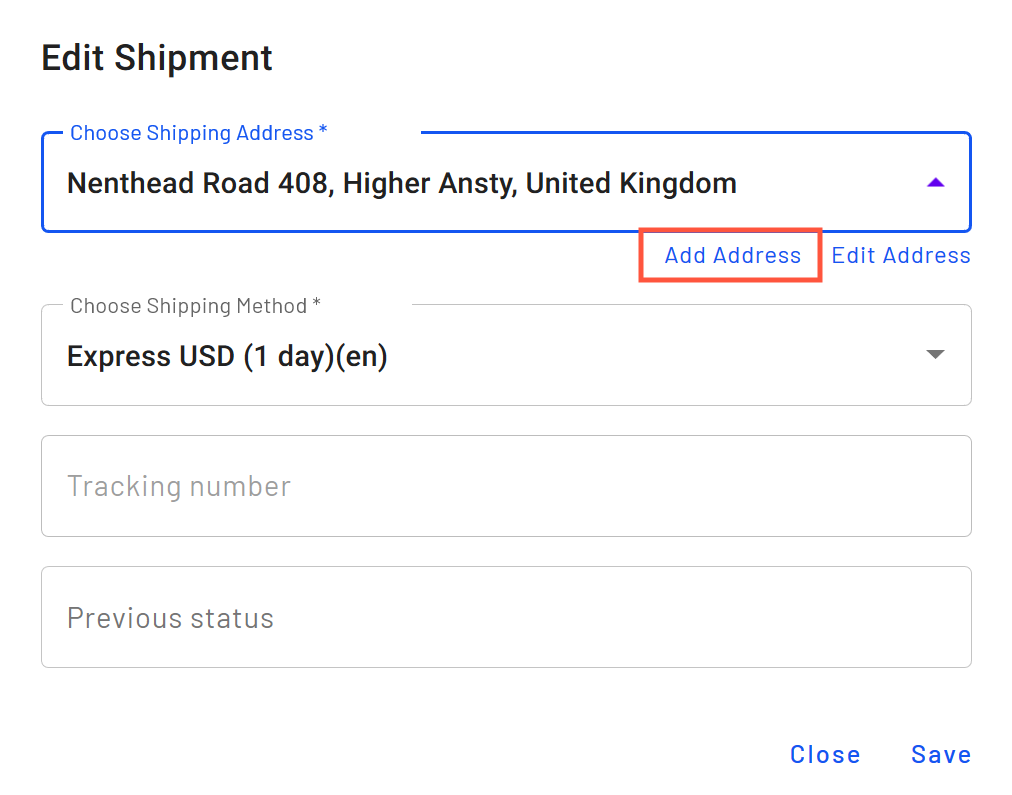
- Enter the address information.
- If you want to add the new shipping address to the customer's address book to use it for further orders, select the Add to customer's address book check box.
- Click Save > Close.
Changing the customer address does not affect the order's shipping address.

